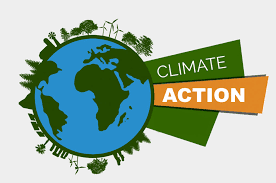i. Climate Education is a climate solution. Climate education and communication hold a key solution in increasing the awareness campaign on climate action, especially mainstreaming Climate education into the school curricula and grassroots community programs. It is only through education that students can develop climate solutions. By incorporating climate change and environmental sustainability into the curriculum, we can equip future generations with the tools they need to address the challenges of climate change. The populace needs to be educated on climate impacts, policies and action plans, through consistent awareness, enlightenment, trainings and engagements to drum local support and contextual action for climate solution.
ii. Climate resilience of agroecosystems and socioeconomic livelihood is strengthened by community initiatives for collective action to improve the surrounding natural resources and ecosystems for a sustainable future. Local communities approach climate adaptation response in a way that uses several traditional knowledge and indigenous solutions. Local adaptation capabilities and resilience against climate change can be increased using methods specific to their environment. Therefore, there is a need to boost subnational efforts to enhance local communities in developing indigenous adaptation solutions and implementing actions to respond to current and future climate change impacts.
iii. Funding and support need to be directed to areas that are most vulnerable and require urgent action; because by understanding the varying impacts and risks at the subnational level, resources can be allocated more effectively.
iv. Climate policies should be designed with the local context in mind, involving local communities in the decision-making process foster to a sense of ownership and responsibility towards climate action, to ensure that climate action is practical, achievable, and resonates with the local population. This will increase the likelihood of successful climate policy implementation and sustainability of climate action initiatives.
v. There is a need to develop and promote climate change vulnerability assessments and adaptation strategies for addressing climate change, mainly as regards local to regional-scale vulnerability assessments and adaptation plans; especially considering the surge in the number and frequency of adaptation practices and initiatives in all of Nigeria’s agroecological zones due to the increasing impacts of climate change.
vi. There is a need to enhance the ability of decision-makers to understand and plan for environmental change by putting people-centred and gender-sensitive analysis at the centre of climate adaptation. By integrating population data in climate adaptation planning, policymakers can provide a more comprehensive understanding of vulnerability and develop means for resilience.
vii. There is also the need to develop and implement relevant international and regional frameworks to ensure that all climate adaptation measures to address climate vulnerabilities take into account the specific needs of the locals: farmers, women, children, youth, persons with disabilities and other marginalized groups following relevant human rights and other instruments.
viii. Addressing climate risks at the subnational level requires better planning and implementation of adaptation measures, including building resilient infrastructure, implementing early warning systems, and developing climate-resilient agriculture and water management practices. There is to need to support community resilience built through climate-smart investments that allow local farmers, women and young people to take a greater role in decision-making over their futures.
ix. There is a need for coordination and collaboration among various stakeholders at the subnational level. Government bodies, communities, NGOs, and businesses can work together to address climate challenges more effectively. Support and stakeholders engagement programs is key to ensure inclusive participations and shared responsibility of climate action.
x. State governments should explore local solutions that promote equity and community engagement through inclusive decision-making to reflect communities’ diverse needs, concerns, and aspirations in the face of climate challenges. Subnationals should be seen supporting local communities to identify priority needs and collaboratively plan for climate adaptation, with access to decentralized climate funding.
xi. State government should establish an Indigenous knowledge research hub and local advisory committee to guide on a system change to accommodate climate vulnerabilities and, in the process, thrive and recover from any eventuality. National action plans must imbibe adaptation actions that are based on and guided by the best available science (funded research) and, as appropriate, traditional knowledge, knowledge of indigenous peoples and local knowledge systems, to integrate adaptation into socioeconomic and environmental policies and actions.
xii. Bringing up the discourse on subnational involvements will also give credence and voice to the much talked about Locally led adaptation (LLA), which unlocks, supports and leverages the high potential and innovative capabilities of communities to develop and implement solutions. Thus, there is a need for coordinated practices and principles for climate resilience that integrate multiple locally-led adaptation responses, including Indigenous solutions and local knowledge, to ensure climate-proofing and sustainability of agricultural ecosystems.
Timothy Emenike Ogenyi,
Senior Climate Policy Analyst,
Society for Planet and Prosperity (SPP)






